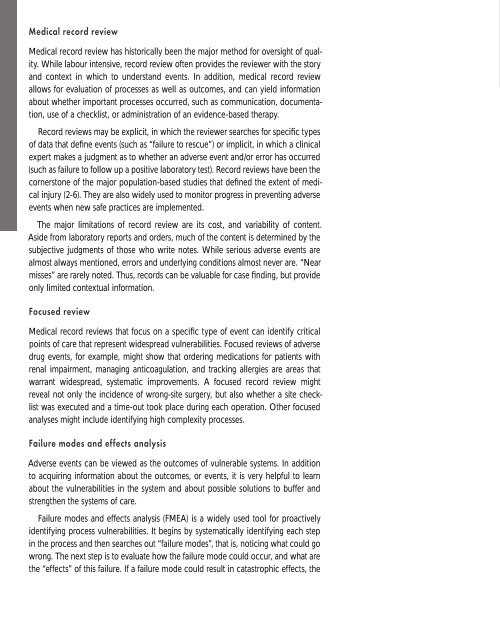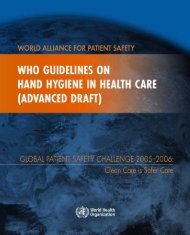Adverse event reporting.pdf
Adverse event reporting.pdf
Adverse event reporting.pdf
Create successful ePaper yourself
Turn your PDF publications into a flip-book with our unique Google optimized e-Paper software.
Medical record review<br />
Medical record review has historically been the major method for oversight of quality.<br />
While labour intensive, record review often provides the reviewer with the story<br />
and context in which to understand <strong>event</strong>s. In addition, medical record review<br />
allows for evaluation of processes as well as outcomes, and can yield information<br />
about whether important processes occurred, such as communication, documentation,<br />
use of a checklist, or administration of an evidence-based therapy.<br />
Record reviews may be explicit, in which the reviewer searches for specific types<br />
of data that define <strong>event</strong>s (such as “failure to rescue”) or implicit, in which a clinical<br />
expert makes a judgment as to whether an adverse <strong>event</strong> and/or error has occurred<br />
(such as failure to follow up a positive laboratory test). Record reviews have been the<br />
cornerstone of the major population-based studies that defined the extent of medical<br />
injury (2-6). They are also widely used to monitor progress in pr<strong>event</strong>ing adverse<br />
<strong>event</strong>s when new safe practices are implemented.<br />
The major limitations of record review are its cost, and variability of content.<br />
Aside from laboratory reports and orders, much of the content is determined by the<br />
subjective judgments of those who write notes. While serious adverse <strong>event</strong>s are<br />
almost always mentioned, errors and underlying conditions almost never are. “Near<br />
misses” are rarely noted. Thus, records can be valuable for case finding, but provide<br />
only limited contextual information.<br />
Focused review<br />
Medical record reviews that focus on a specific type of <strong>event</strong> can identify critical<br />
points of care that represent widespread vulnerabilities. Focused reviews of adverse<br />
drug <strong>event</strong>s, for example, might show that ordering medications for patients with<br />
renal impairment, managing anticoagulation, and tracking allergies are areas that<br />
warrant widespread, systematic improvements. A focused record review might<br />
reveal not only the incidence of wrong-site surgery, but also whether a site checklist<br />
was executed and a time-out took place during each operation. Other focused<br />
analyses might include identifying high complexity processes.<br />
Failure modes and effects analysis<br />
<strong>Adverse</strong> <strong>event</strong>s can be viewed as the outcomes of vulnerable systems. In addition<br />
to acquiring information about the outcomes, or <strong>event</strong>s, it is very helpful to learn<br />
about the vulnerabilities in the system and about possible solutions to buffer and<br />
strengthen the systems of care.<br />
Failure modes and effects analysis (FMEA) is a widely used tool for proactively<br />
identifying process vulnerabilities. It begins by systematically identifying each step<br />
in the process and then searches out “failure modes”, that is, noticing what could go<br />
wrong. The next step is to evaluate how the failure mode could occur, and what are<br />
the “effects” of this failure. If a failure mode could result in catastrophic effects, the
















